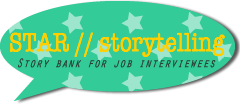
Table of Contents
Not sure where to start?
The “STAR story pyramid” is a framework that helps you with your story building thinking. At the bottom of the pyramid is the “What” (your impact to e.g., products, processes) and at the top is the “Why” (your call to action). The middle is the “How” you have navigated upheavals with your skills.

Use the framework either from the bottom up or the other way round. However, before delving into the pyramid, let’s do our homework in four steps.
1. Line up the expected job interview questions and must-have skills

The most common job interview questions are asked to find out if there is a good fit with the company and the role. They come mainly from two sources: 1) the company values and 2) the job description.
Have a look at the company’s W/site and see what values are important for the organisation. For example, if one of the company’s values is “integrity“, be ready to prepare examples about when you have proved your integrity.
As for the job description, just read between the lines and it will tell you what questions you might expect to be asked. For example, if the specs look for candidates who are strong with numbers, think about where the numerical skills apply to. For a Data Scientist role, “Tell me about a time when you have built/solved a model“, “…built an algorithm” can be likely questions. If you are applying for an Associate position in Venture Capital, “Tell me about a time when you have calculated the IRR for an investment” or “…built a cap table”, these could be examples of number-related questions.
2. List down your relevant past experiences and metrics

Drawing on the above questions, consider any project/task you went through, people you have worked with, clients you have served but also extracurricular activities where you have proved yourself. Any progress made can be measured. For each business’ task, you must know your metrics (i.e., how your performance is tracked and valued). These vary according to industry and business model.
3. Look back to any acknowledgment you have received

Whatever internal problem or external challenge you have solved, whether in person or in writing, you might have been commended, promoted, assigned to special tasks, or you saw/read stats about you and your team performance or received some compliments/kudos.
4. Write your stories with the Story Napkin

The Story Napkin is a template with awesome guidelines. Use it together with the STAR story pyramid. Download it for free here.
Need inspiration?
Download fresh stories straight from your field and learn from your industry peers.
Want To Earn From Your Stories?
Upload and sell them here.
Rehearse, Rehearse, Rehearse. Good luck and let us know how it did go!
Did you miss our last post? Read it here.
